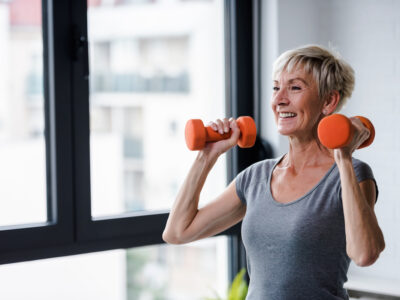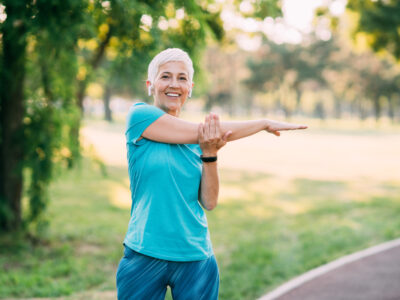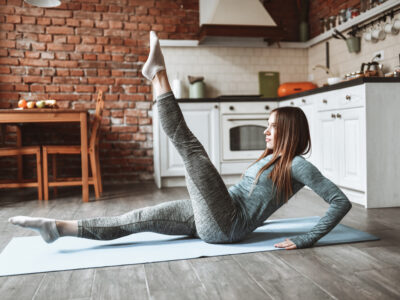Table of Contents[Hide][Show]
Think of some of the seniors you know (or maybe you are one yourself). Many may be living a fulfilling, busy life, gathering with friends, socializing, and making the most of their golden years.
What keeps them so young, physically and psychologically?
Exercise!
While there are no guarantees, exercising can help you live a mobile, independent senior lifestyle.
Let’s take a look at some of the best exercises for seniors and how they can benefit your mind and body.
Why Exercise Is Important for Seniors
Before we share the most recommended exercises for older adults, it’s important to understand why you’re exercising.
It’s not for vanity or superficial reasons.
Exercising plays a vital role in keeping your body healthy, energetic, and mobile as you grow older.
Here are some of the main benefits of exercise for seniors.
Reduces Your Risk of Falling
Although any person of any age can fall, falling is particularly hazardous for older adults. Not only are you more likely to suffer a more severe consequence, such as a broken bone instead of a bruise, but your body will also take longer to heal than when you were younger.
Strengthening your muscles so that you can remain steady and stable on your feet is a great start. You should also incorporate balance exercises into your exercise routine to further protect yourself from falling.
Eases Arthritis Pain
Arthritis is one of the most common ailments among seniors, affecting over 47% of adults aged 65 and over.
Light, low-impact exercise strengthens your muscles, thus taking pressure off your joints and helping reduce the pain of arthritis.
Exercise, especially strength training and stretching, also helps lubricate your joints and muscles, reducing some of the stiffness and pain caused by arthritis.
Related
Fitness Boost: The Best Strengthening Exercises
Check out our top strengthening exercises for the lower body, upper body, core, and back, plus 5 tips for making the most of your workout.
Improves Your Mood
Exercising releases chemicals such as serotonin and endorphins, the “feel good” hormones. At any age, this can improve your mood, promote positivity, and balance your emotions.
For seniors, exercising can also support independent living, which further encourages a happier mood.
And if you exercise with others, either at a community center or with friends, socializing and making connections further improves your mood and mental health.
Helps You Remain Independent
Strong healthy muscles are necessary for you to maintain your everyday tasks, from walking to bathing to cooking.
Being strong enough to do these things for yourself means you can rely less on others and remain self-reliant and independent.
Aerobic Exercises for Older Adults
Cardiovascular exercises can increase your stamina and endurance, helping you keep up with your favorite everyday activities.
It also strengthens your lungs and heart and improves your cardiac function, reducing the risk of cardiovascular mortality.
According to the Centers for Disease Control (CDC), the ideal amount of aerobic exercise for adults aged 65 and older is:
- 150 minutes per week of moderate exercise (i.e. walking)
- OR 75 minutes per week of vigorous exercise (i.e. jogging or running)
For most seniors, the ideal balance would be 30 minutes of moderate aerobic exercise per day, 5 days per week. It’s up to you whether you prefer to do this all at once or spread them out in 10 or 15-minute sessions throughout your day.
Here are some of the best aerobic exercises for seniors.
- Walking
- Swimming
- Water aerobics
- Stationary bicycle
- Dancing
- Any other activity that raises your heart rate, including daily activities such as yard work or house cleaning
As you age, your body will naturally find a new rhythm while exercising.
Don’t be discouraged if you can’t walk as fast or as far as you once did. And don’t push yourself too hard to start. With consistency, your body will keep improving!
Strengthening Exercises for Older Adults
One of the most important exercises for older adults is strength training, ideally twice per week.
As we mentioned earlier, having stronger muscles can reduce your chances of falling, thus preventing serious fall-related injuries. In addition, having strong muscles can help make your day-to-day tasks feel easier and more manageable, increasing your independence.
But there’s another big reason why strength training should be part of your exercise routine.
Studies show that roughly 30% of adults over the age of 70 have compromised mobility, struggling to complete basic activities such as walking, standing up from a chair, or walking up a set of stairs.
This is mostly due to a condition known as sarcopenia, the age-related loss of muscle mass and strength. Fortunately, research shows that sarcopenia can be prevented, managed, or even reversed through strength training.
Here’s the good news. You don’t have to lift heavy dumbbells or add extra weights to gym equipment.
In fact, some of the most effective strength training exercises for seniors use only light hand weights, resistance bands, or even just your body weight.
For strength-training purposes, here are some of the best exercises for seniors.
Related
How to Improve Mobility
Learn how to improve your mobility with some mindfulness tips and mobility exercises for some of the most problematic spots—the ankles, hips, and shoulders.
Bodyweight Exercises
Body weight exercises are easy to do anywhere and require zero costly equipment.
These are some of the best bodyweight exercises for older adults.
- Squats, which strengthen almost all of your lower body. You can do these with just body weight, or work your way up to holding light weights at your side for added resistance.
- Push-ups, on your knees or toes. If you can’t do push-ups on the floor, you can do them against a wall. Push-ups strengthen your upper body for everyday activities, such as carrying groceries, and also help you maintain your posture as you age.
- Glute bridges, which strengthen the muscles in your glutes, hips, and hamstrings, while also working your back and core.
- Core exercises, such as planks or bird-dogs. Contrary to popular belief, core exercises don’t just strengthen your abdominal muscles. They also strengthen your back muscles, alleviating potential back pain and helping you maintain a strong, erect posture.
- Some yoga postures, which are held for a longer time period, are also great bodyweight exercises
Resistance Band Exercises
Resistance bands are lightweight, flexible bands that you can use to add more power to your strength training. Depending on which band you’re using, it may be more or less stretchy. The stretchier bands provide less resistance; eventually, you can work your way up to stronger bands.
Here are some resistance band exercises to try.
- Leg press
- Tricep press
- Bicep curls
- Chest flies
- Shoulder press
- Rows
Dumbbell Exercises
Once you feel ready, you can start incorporating light dumbbells into some of your strength training exercises.
Here are a few to add to your routine.
- Front press
- Overhead press
- Front raises
- Lateral raises
You can also replace your bands with dumbbells, for added resistance during these exercises.
- Tricep press
- Bicep curls
- Shoulder press
When strength training with dumbbells, it’s important to pick a weight that offers resistance but that you can still control. Then build your way up to heavier weights gradually to avoid injury.
Balance Exercises for Older Adults
Balance exercises are another vital component of any exercise program for seniors.
According to the CDC’s Physical Guidelines for Americans, balance exercises can help prevent you from falling and also significantly reduce the risk of injuring yourself if you do happen to fall.
Here are some examples of balance exercises.
- Walking heel-to-toe
- Standing up from a seated position, without using your arms to push yourself up
- Foot taps, where you slowly raise one foot up to tap on a step or low piece of furniture while balancing on the other leg
- Single-leg step-ups onto a low step or ledge (If you feel wobbly, you can do these next to a wall or chair to steady you until you get more comfortable and improve your balance enough to do these on your own.)
- Single-leg balance, during which you’ll pull one knee up toward your chest while standing balanced on the other foot
Aim for at least three sessions of balance exercises per week, mixed in with your aerobic or strength training exercises.
Flexibility Exercises for Older Adults
As you get older, you may start to feel a reduced range of motion. Even something that was once as simple as reaching for something overhead or turning to see something can feel challenging if your muscles are too tight.
Flexibility exercises gently stretch your muscles can help you widen your range of motion and keep your muscles supple.
Here are some great stretches to improve your flexibility.
- Chest stretch: Standing in an open doorway, place one hand and forearm against the door frame with your elbow bent up at a 90-degree angle. Gently turn your torso and push it forward to feel a stretch, then alternate sides.
- Hip flexor stretch: Lie flat on your back and bend your right knee. Cross your left foot over your right knee. With the palm of your left hand, gently push your left knee away from your body. Alternate sides when you’re done.
- Back and chest stretch: Clasp your hands behind your back, fingers interlaced and palms facing behind you. Push your hands away from your body and squeeze your shoulder blades together. Alternate this with the front version, bringing your hands in front of you, palms facing forward. Interlace your fingers and push your hands forward while rounding your back.
- Neck stretch: Raise your right arm to the side, elbow straightened, hand to shoulder height. Place your left hand near your right ear and gently guide your left ear to your left shoulder. You can deepen this stretch further by wrapping your right arm towards your back, with the top of your hand (not your palm) resting on your lower back. Release and alternate sides.
Aim to hold your stretches for at least 30 seconds, breathing steadily the whole time. If you want to deepen a particular stretch, do it during your exhale.
One important thing to keep in mind is that stretching should not be painful. If a particular stretch hurts, release it immediately. You can try again, less deep and more gently, at a later time.
8 Tips for Exercising as an Older Adult
As you age, exercising will feel different, so adaptability is key.
Here are some tips to keep in mind as you add exercise.
- Have realistic expectations for yourself. When you’re first starting out, give your body time to respond.
- Find something you enjoy! If you love to dance, there are dance classes for seniors that you might enjoy. If you love to swim, find a local pool. The more you enjoy exercising, the more likely you are to stick with it.
- Aim for moderate exercise. You should be able to feel your muscles working, without pushing them to the point of soreness.
- If a particular move hurts or causes you discomfort, stop.
- If you’re recovering from an injury or illness or if it’s been a while since you engaged in physical activity, ease back into an exercise lifestyle. Start off slowly, and work your way up to longer intervals.
- Add more physical activity into your daily routine, even if it’s just walking instead of driving to the store.
- Take a vitamin K2-7 supplement, such as this one from Just Thrive. This crucial vitamin plays a huge role in healthy aging and supporting longevity as well as optimizing your heart, bone, and brain health.
- Always consult with your doctor before beginning a new exercise program.
Final Thoughts
As you grow older, you’ll notice many changes in your body. But that doesn’t mean you can’t still be fit, active, and glowing with health and energy.
Start or increase your weekly physical activity with a variety of these exercises, and you’ll soon see and feel the difference!
You May Also Like…






